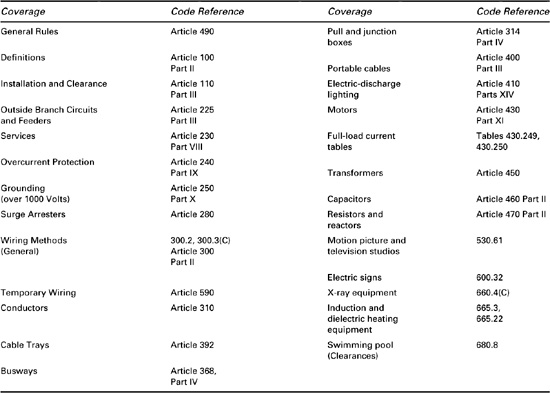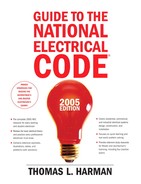Chapter 12
Special Conditions and Communications Circuits
Chapter 7*
*References in the margins are to the specific applicable rules and tables in the National Electrical Code.
Special conditions are recognized in the code that require wiring methods and installation techniques that differ from those specified by general rules. The requirements for systems and circuits representing such special conditions are covered in this chapter. Emergency systems, standby systems, and remote-control circuits are examples of systems or circuits that require special consideration for wiring methods and installation.
Chapter 8
The code provides rules for the installation of communications systems that differ from those for power and lighting systems. Communications circuits, radio and television equipment, and community antenna television (CATV) systems must be installed according to specific Code requirements. Each of these communications systems will be discussed.
Special rules apply to circuits and equipment operating at over 600 volts. The last section in this chapter considers these installations.
12–1 Emergency and Standby Systems
ARTICLE 700
In many occupancies, a supplementary electrical system is required to supply illumination and power when the normal electrical supply is interrupted. Municipal, state, or federal regulations require emergency systems in most public buildings. These systems are intended to maintain illumination and provide power for equipment that is essential for the safety of the occupants. The Code specifies rules for emergency systems that supplement or supercede the requirements for ordinary circuits and equipment.
ARTICLE 701
ARTICLE 702
The Code defines installation and operational rules for the standby power systems required by municipal, state, or federal regulations. Such systems are intended to supply power to critical equipment other than that which is part of the emergency system. Code provisions also are specified for optional standby systems. These systems are intended to protect private business interests or property where life safety does not depend on the performance of the system.
12–1.1 Emergency Systems
ARTICLE 700
700.12
700.5
The electrical requirements for emergency systems for wiring and circuits for lighting and power are summarized in Table 12–1. Other specific rules for transfer switches and the source of emergency power are specified in the Code. The alternate power source must transfer power to the emergency system within 10 seconds after the failure of the normal supply. The emergency system has the highest priority if the alternate supply also powers standby loads when the normal power source is interrupted.
Table 12–1. Rules for Emergency Systems
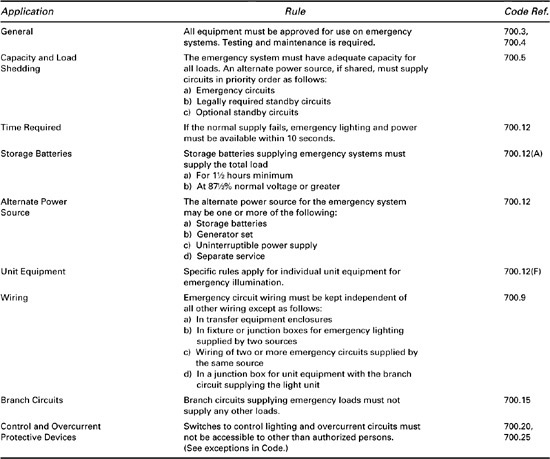
700.1
In addition to emergency lighting, emergency systems are used to provide power for equipment necessary for public safety in structures like hotels, theaters, sports arenas, and health care facilities. Such equipment may include essential ventilation, fire detection and alarm, elevators, fire pumps, and public communication systems. Branch circuits for emergency lighting and power must be installed as separate circuits to provide power to the emergency loads after the normal power supply to the building fails or is interrupted.
700.15
700.20
700.25
Emergency circuit wiring must be kept independent of all other wiring. This emergency circuit wiring must not enter a raceway, cable, box, or cabinet used by the normal wiring for the building except in the cases listed in Table 12–1. Branch circuits for emergency loads must not supply any other loads. Any switch to control an emergency lighting circuit must be accessible to authorized persons only. The branch-circuit overcurrent protective devices must also be located so that they are accessible to authorized persons. These provisions are intended to ensure that wiring, switches, and overcurrent protective devices for emergency systems are not mistaken for circuits or devices for ordinary use and to assure that they will not be accidentally disconnected or switched off.
12–1.2 Standby Systems
ARTICLE 701
In addition to the emergency system, many occupancies have a standby power source required by municipal, state, or federal regulations. Such a standby system is called a Legally Required Standby System in the Code. The system is intended to supply equipment that must continue to operate if the normal power source is interrupted. For example, this equipment may be important to rescue or fire-fighting operations, heating or refrigeration, communication, or ventilation within a building, but it does not include equipment that is essential for human safety like emergency equipment as defined in the Code.
701.11
ARTICLE 700
Table 12–2 summarizes many of the requirements for legally required standby systems. These rules are quite similar to those for emergency systems. However, the transfer of power from normal power sources to the standby system can occur within 60 seconds. Also, wiring for a legally required standby system is allowed to occupy the same raceway, cable, or enclosure as normal circuit wiring. Emergency systems have stricter requirements.
Table 12–2. Rules for Legally Required Standby Systems

702.2, 702.5
The Code also treats standby systems that are installed to minimize discomfort or economic loss in the event that normal power is interrupted. These alternate power sources are called Optional Standby Systems. An uninterruptible power supply for a computer system is an example of an optional standby system if the computer system is used for general data processing and does not control any equipment essential for safety. No special requirements for wiring or installation are given in the Code for optional standby systems as long as the system is approved for its intended use and has adequate capacity for the loads to be served.
12–2 Remote-Control, Signaling, and Power-Limited Circuits
ARTICLE 725
725.2,
The Code recognizes circuits for remote-control applications and signaling that are limited in power compared to those that supply lights and general-use equipment. Therefore, alternative requirements are specified in the Code for such circuits with respect to conductor sizes, overcurrent protection, and wiring methods and materials. These circuits are separated into Class 1, Class 2, and Class 3 circuits according to usage and electrical power limitations. Generally speaking, remote-control, signaling, or power-limited circuits are considered less hazardous than circuits for power and lighting. Therefore, the requirements for installing these limited energy circuits are not as strict as those for general wiring in a building.
ARTICLE 100
Remote-control circuits include those for control of motors, heating units, and similar equipment. These circuits control the power circuit supplying the equipment by energizing or deenergizing a relay or device like a motor contactor to start and stop the unit. Signaling circuits include those for burglar alarms and circuits for communication or data transfer not covered elsewhere in the Code.
ARTICLE 645
Other systems of this type that have specific rules are treated in Sections 12–3 and 12–4 of this Guide. Cables for signaling or data transfer that run from a computer room to remote equipment such as terminals or printer units may be considered signaling circuits according to the application.
12–2.1 Class 1 Circuits
725.21
725.11
The basic rules for the design and installation of Class 1 circuits are given in Table 12–3. If the power to the control or signaling circuit is limited to 1000 volt-amperes, the circuit is classified as a Power-Limited Class 1 circuit. Otherwise, a Class 1 circuit can operate at up to 600 volts. Any remote-control circuit for safety-related equipment is also considered a Class 1 circuit even if its limited power supply would otherwise qualify it as a Class 2 or Class 3 circuit.
Other rules in Table 12–3 concern the wiring methods and materials for Class 1 circuits. The reader is referred to the Code for specific details.
Table 12–3. Rules for Class 1 Circuits
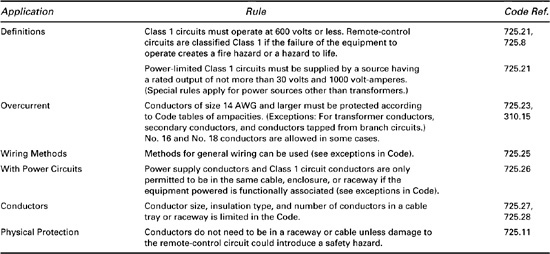
12–2.2 Class 2 and Class 3 Circuits
ARTICLE 725, PART III
725.55
725.54
Conductors and equipment on the load side of overcurrent protective devices, transformers, or current-limiting devices can be classified as Class 2 or Class 3 control or signaling circuits if the energy that can be supplied to such circuits is inherently limited. For example, a power supply consisting of batteries and operating at less than 30 volts with limited capacity would be considered as an inherently limited power source. In most cases, Class 2 or Class 3 circuits must not be run with circuits for lighting and power or with Class 1 circuits. The Code specifies various restrictions and exceptions for Class 2 and Class 3 wiring and other circuits.
12–3 Other Special Conditions
ARTICLE 760
ARTICLE 770
Several special systems are recognized in the Code for signaling, communication, or control purposes that do not qualify as remote-control, signaling, or power-limited circuits as discussed in Section 12–2 of this Guide. These special systems include Fire Alarm signaling systems that are intended primarily to alarm or control sprinkler systems in the event of a fire at a protected site. The installation of optical fiber cables is also treated in the Code. Such cables are typically used to connect local area networks of a computer system. For fire protective circuits and optical fiber cables, the Code is primarily concerned with the fire hazard caused by the spread of fire along the cables or circuits. The circuits or cables themselves present little hazard because of the limited energy associated with such systems.
ARTICLE 720, ARTICLE 780
Other special conditions treated in the Code include circuits operating at less than 50 volts and closed-loop and programmed power distribution systems. The reader is referred to the Code for the few rules that apply to these special installations.
12–4 Communications Systems
CHAPTER 8
Table 12–4 summarizes the topics treated in the Code for communications systems. Communications circuits include telephone systems not controlled by communication utility companies and similar systems not covered elsewhere in the Code. Rules are also provided for the installation of radio and television antennas and other equipment. Cable television and similar installations are also treated. Many of the rules for these systems concern the clearance from power conductors and the proper grounding procedure.
Table 12–4. Rules for Communications Systems
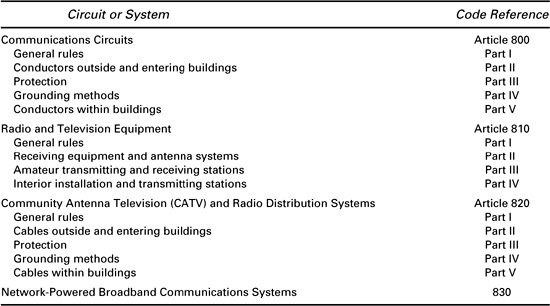
12–5 Circuits and Equipment Operating at Over 600 Volts
ARTICLE 490
The Code distinguishes between circuits operating at 600 volts and below and those operating at over 600 volts. Safety and protection of property are the main considerations in the Code for circuits and systems operating at over 600 volts. Safety aspects include precautions for maintenance and operating personnel as well as the general public. To achieve the safety and protection required, the Code specifies rules for circuits and equipment for use at over 600 volts. Rules are specified for the wiring methods and the equipment used in installations as well as for the accessibility of enclosures and circuit conductors. Power switchgear, mobile equipment, and electrode-type boilers are given special consideration in the Code. The reader is referred to the Code for specific requirements.
Provisions that apply to circuits and systems operating at over 600 volts are contained in a number of articles in the Code as listed in Table 12–5. These rules modify or supplement the more general rules in Article 490 when specific circuits or systems are designed or installed.
Table 12–5. Installation Rules for Systems Operating at More Than 600 Volts
